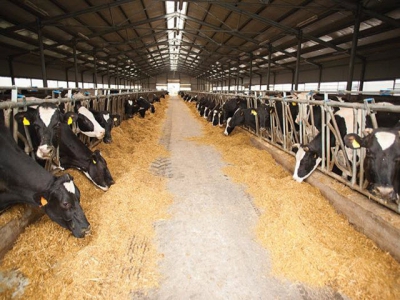Managing corn mycotoxin levels in dairy cattle feed

Learn what an industry professional has to say about the risk of feeding mycotoxins.
“One of the very first things we need to consider when we talk about harvest and mycotoxins for ruminants is weather patterns,” said Dr. Max Hawkins, a nutritionist with the Alltech Mycotoxin Management Team. If we think about the weather stresses that this year’s crop had to endure during pollination, late maturity and harvest we know that there were certainly some areas with above average precipitation in July and August, even late into the fall. This certainly left an impact on crops, he explained.
Corn silage analysis
Corn silage samples averaged a little over five mycotoxins per sample out of 200 trials, compared to last year’s average of 3.6 mycotoxins per sample. There were multiple mycotoxins present in nearly all the samples, and only 2.5 percent contained one mycotoxin. The largest amount found while sampling was 10 mycotoxins. It is important to understand that once there are mycotoxins in the crop, they will not go away.
“Aflatoxin B1 was present in over 10 percent of the samples, which is somewhat concerning, particularly with dairy cattle,” Hawkins said. This can increase in storage, so it is important to monitor it very closely in terms of milk quality and the ability to have saleable milk. “Silage management and storage is going to be critical as we move through the feed out of 2017 corn silage,” he explained. In the springtime, they will do a storage analysis to see how levels have shifted and what worked in terms of maintaining them.
Emerging mycotoxins were also present in about 24 percent of the samples. Trichothecene were also very prevalent, showing higher numbers than last year for both type A and B. These things can have a big impact on dry matter intakes, gut health, milk production, gain, feed efficiency and general animal health, Hawkins added.
“Silage management and storage is going to be critical as we move through the feed out of 2017 corn silage." – Max Hawkins
“The variation of risk that’s present in corn silage to dairy cattle is near 60 percent at high risk and for beef cattle it’s almost 50 percent; what this tells me is if I’m feeding corn silage, I want to know what the level of mycotoxins is,” said Hawkins.
The level of mycotoxins in dairy cattle has a lot to do with gut health, and this can relate to other health issues. Beef cattle tolerance to mycotoxins is higher; also, the pressure on their rumen and rumen turnover is not as high in beef cattle. With the same silage fed to calves and young heifers, risk can be very high, especially with dealing with heifer development.
Corn silage risk distribution is pretty much spread across the U.S. “However, just because your neighbor has a sample that comes back low-risk, it may not mean anything to me, even if they live across the street. We could have that much difference in a small geographical area due to crop maturity, timing of harvest, timing of late season rains — all kinds of things can influence what the mycotoxin risk will be in a harvested corn silage,” he said.
In concentrated areas where risk is high for dairy cattle, it is likely still high for beef cattle.
Corn mycotoxin levels
Out of 100 samples of corn grain, the average samples were 4.28 percent mycotoxins; if we look at that in relationship to last year, they were only at 2.7 percent, so once again, there is almost double the mycotoxins. There was a little over 1 percent that had zero mycotoxin; however, the bulk of samples did have them.
Trichothecene type B was present in over 90 percent of the samples. Other mycotoxins are also very prevalent.
About 50 percent of the samples were at moderate and high risk for dairy cows, while about 40 percent were moderate and high risk for beef cattle.
Inclusions will moderate some risk, he explained. Especially beef feeder cattle that are on a higher corn-based diet. Some of the prevalent mycotoxins could be high risk for dairy heifer development.
Looking at risk areas, it appears that risk is less in the West and increases to the East. “These mock some of the rainfall we previously saw,” he said. Once again, storage will be important as corn is continued to be fed.
“Yield does not indicate quality; you could have a record yield and a record level of mycotoxins,” Hawkins said. This year with the cool, wet weather, the late maturity and later harvest, it could really cause more issues. Also, with corn prices still low producers may try to control corn in storage strictly with aeration, which could result in some issues, he explained. “Last year, we had a lot of spoiled corn in storage that led to some of the highest level of mycotoxins that we had seen in recent years,” Hawkins said. This year could mimic those issues, he suggested.
High moisture corn can increase the risk for mycotoxins. While there are some samples of high-moisture corn that do not show mycotoxins, often the high-moisture corn samples did show some level of the issue.
“I would encourage you to get samples tested,” he concluded.
Related news
Tools

Phối trộn thức ăn chăn nuôi

Pha dung dịch thủy canh

Định mức cho tôm ăn

Phối trộn phân bón NPK

Xác định tỷ lệ tôm sống

Chuyển đổi đơn vị phân bón

Xác định công suất sục khí

Chuyển đổi đơn vị tôm

Tính diện tích nhà kính

Tính thể tích ao



 Cow/calf producers should estimate winter feed needs
Cow/calf producers should estimate winter feed needs  Tips for feeding livestock agro-industrial waste
Tips for feeding livestock agro-industrial waste